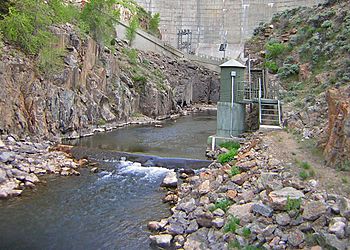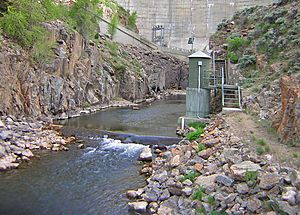Williams Fork (Colorado River tributary) facts for kids
Quick facts for kids Williams Fork |
|
|---|---|
 |
|
| Physical characteristics | |
| River mouth | Confluence with Colorado 7,480 ft (2,280 m) |
| Length | 34 mi (55 km) |
| Basin features | |
| Progression | Colorado |
The Williams Fork is a river in north-central Colorado, United States. It's a smaller river, about 33.8 mi (54.4 km) long. This river is an important tributary (which means a smaller stream or river that flows into a larger one) of the mighty Colorado River. It flows through Grand County, a beautiful area known for its mountains and outdoor activities.
Contents
Where Does the Williams Fork River Start and End?
The River's Journey
The Williams Fork River begins where two smaller streams, McQueary Creek and Bobtail Creek, meet. This spot is located just west of the Continental Divide. The Continental Divide is like a giant imaginary line that separates which ocean rivers will flow towards.
High Up in the Mountains
The river's starting point is high up in the Arapaho National Forest. It's about 8 mi (13 km) west of Berthoud Pass and 7 mi (11 km) north of the Eisenhower Tunnel. These are well-known landmarks in the Rocky Mountains.
Flowing Through Grand County
As the Williams Fork flows, it travels generally north-northwest. It passes between the valleys of two other rivers: the Fraser River and the Blue River. These valleys are home to many plants and animals.
Joining the Colorado River
The river eventually reaches the Williams Fork Reservoir. This is a large lake created by a dam. After the reservoir, the river turns northeast and finally joins the much larger Colorado River near a place called Parshall.
What is the Williams Fork Reservoir?
A Man-Made Lake
The Williams Fork Reservoir is a big lake formed by the Williams Fork Dam. This dam was built across the river to create a place to store water. Reservoirs like this are very important for people and wildlife.
Why is the Reservoir Important?
The water stored in the Williams Fork Reservoir is used for many things. It helps provide drinking water for communities. It also supports farming by providing water for crops. Plus, it's a popular spot for fishing and other outdoor fun!


